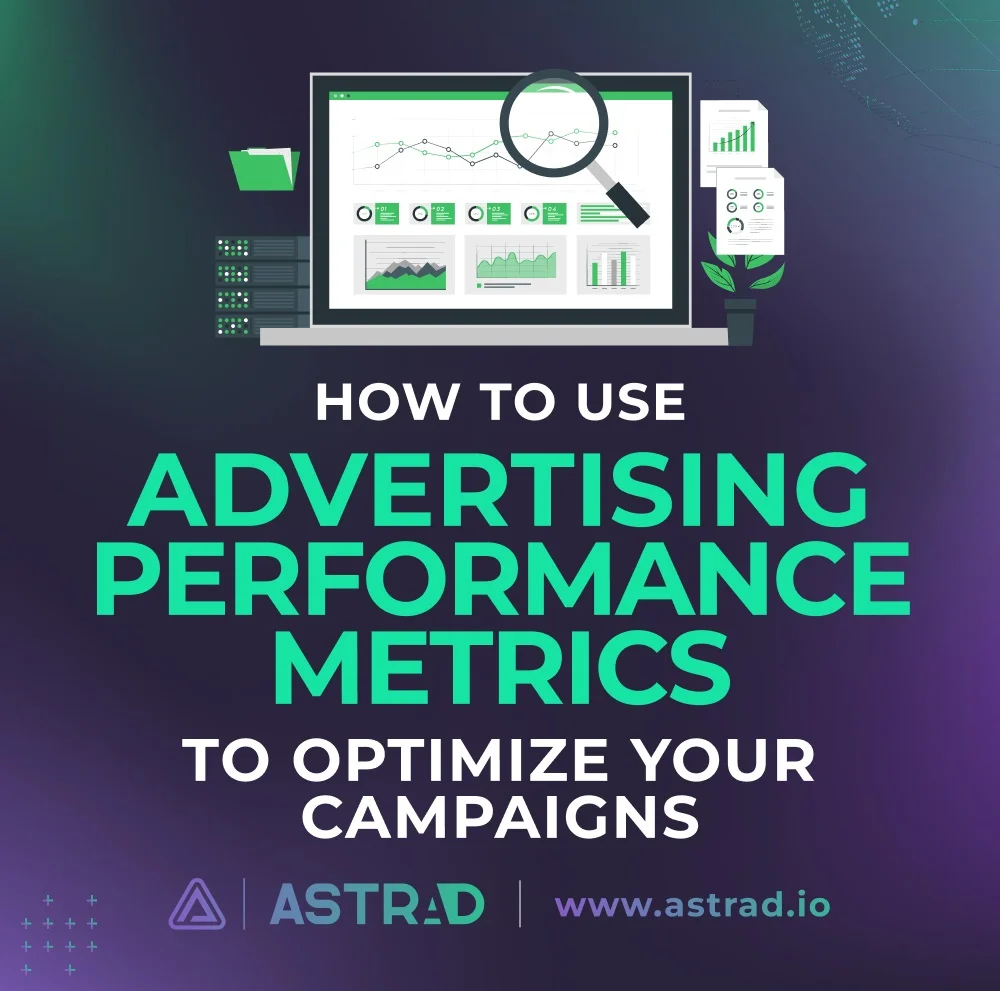Currently, one thing, above everything else, dominates the landscape — Big Data. Companies are fighting like rabid dogs in the Thunderdome over it. Over who has it, who is harnessing it, and how to sell it. And there’s a reason for that. Big Data – and the power of information – is the business world’s cheat codes. Properly using it opens up new vistas.
New ways of cracking your user’s code and ushering in a new era for your company. Unlocking the power of data is paramount to a successful digital marketing strategy. By equipping avant-garde Mad Men and Mad Women with the knowledge and tools to master advertising performance metrics, a company can transform its actions and plans from guesswork to data-driven decision certainties. This empowers your team to optimize campaigns in real time, maximizing every click and impression.
Ultimately, this translates to tangible results — soaring ROI, achieved business goals, and a competitive edge in today’s dynamic digital landscape.
Advertising Performance Metrics in the Digital Age
In the data-driven landscape of digital advertising, success hinges on understanding your audience and the impact of your message. This is where online advertising performance metrics come in — they are your guiding light. Unlike traditional methods with limited tracking, digital channels offer a wealth of metrics: clicks, impressions, conversions, engagement rates, and more.
These provide a detailed picture of who sees your ad, how they react, and where your budget delivers results. In short, metrics become your compass, steering campaigns toward maximum engagement and return on investment in a dynamic and competitive digital landscape.
Metrics and Campaign Optimization and Business Growth
Advertising performance metrics unlock a world where your marketing budget transforms into a self-learning organism. By tracking, analyzing, and understanding key metrics, you gain insights into what resonates with your audience. This empowers you to optimize campaigns in real-time, ditching ineffective placements and doubling down on high-performing channels.
Metrics also reveal valuable audience data, informing future campaign strategies and product development. This data-driven approach fosters deeper customer understanding, fueling innovation and propelling business growth, all thanks to the power of metrics acting as your starting point.
What are Advertising Performance Metrics — A Quick Overview
Digital advertising performance metrics are quantifiable measurements used to assess the effectiveness and impact of advertising campaigns. These metrics provide insight into various aspects of campaign performance, allowing marketers to evaluate and optimize their digital advertising efforts.
These metrics have the ability to provide actionable data for decision-making and optimization by:
Measuring Campaign Effectiveness
Metrics, such as click-through rates, conversion rates, and engagement rates, help measure how well a campaign is performing.
Identifying Audience Response
Metrics like impressions, reach, and frequency help evaluate how many users have been exposed to the campaign and how frequently.
Assessing Return on Investment - ROI
ROAS and cost per acquisition enable marketers to quantify the profitability of their campaigns.
Optimizing Campaign Performance
Monitoring metrics over time allows marketers to make informed decisions on adjustments to targeting, messaging, creative elements, and budget allocation to enhance campaign performance.
Allocating Resources Efficiently
Analyzing metrics allows marketers to determine which channels or strategies deliver the best results.
Benchmarking Performance
Provides context and helps marketers understand whether their campaigns are performing above or below average, leading to opportunities for improvement.
Types of Advertising Performance Metrics
Key digital advertising performance metrics include:
- Click-Through Rate – CTR: Measures the percentage of users who click on an ad after seeing it, allowing assessment of user engagement and indicating how appealing the ad is to the target audience.
- Conversion Rate: Evaluates the effectiveness of ads in driving desired actions, such as making a purchase, signing up for a newsletter, and filling out a contact form.
- Cost Per Click – CPC – and Cost Per Acquisition – CPA: CPC measures the cost of each click on the ad, while CPA measures the cost of acquiring a customer or lead through the ad. These metrics are crucial for evaluating the cost efficiency of advertising campaigns.
- Return on Advertising Spend – ROAS: Calculates the financial return from advertising investments by comparing the revenue generated from the ads to the cost of the ads. It helps measure the effectiveness and profitability of ad campaigns.
- Impressions and Reach: Impressions indicate the number of times an ad is displayed, while reach measures the size of the audience that saw the ad.
- Engagement Rate: Measures interactions with ads beyond clicks, such as likes, shares, comments, and video views. It provides insights into how well the ad resonates with the audience and encourages interaction.
- Quality Score – for PPC campaigns: Assesses the relevance and quality of ads, keywords, and landing pages in pay-per-click – PPC – campaigns. It influences ad placement and cost, helping advertisers optimize their campaigns for better performance.
How to Use Metrics to Optimize Campaigns
Here are some strategies for leveraging metrics to optimize campaigns:
1. Identifying Underperforming Ads and Making Data-Driven Adjustments
By closely monitoring metrics, such as CTR, conversion rate, and ROAS, marketers can identify underperforming ads and make data-driven adjustments to improve their performance.
2. A/B Testing
Involves creating variations of ads with different elements and measuring their performance to determine the most effective components. Marketers can use metrics to evaluate which variations drive higher CTRs, conversion rates, or engagement, allowing for informed decision-making on which elements to optimize.
3. Budget Allocation
Using metrics to track the performance of different campaigns and channels enables marketers to reallocate budget to high-performing initiatives. By directing more spending towards campaigns that yield a higher ROI or conversion rate, businesses can optimize their advertising budget and maximize the impact of their marketing efforts.
4. Target Audience Refinement
Analyzing demographic data, user engagement patterns, and conversion metrics allows marketers to refine their target audience parameters to better reach and resonate with potential customers.
Challenges of Measuring and Interpreting Metrics
There are several common obstacles that can hinder the accuracy and interpretation of metrics:
- Incomplete or Inaccurate Data – Data collection errors, tracking issues, or discrepancies in reporting systems can all contribute to unreliable metrics.
- Vanity Metrics vs. Actionable Metrics – Focusing on vanity metrics, such as likes, shares, or views, rather than actionable metrics, like conversion rates and return on ad spend (ROAS), can lead to a misrepresentation of campaign effectiveness.
- Shifting Consumer Behavior – Changes in technology, user habits, or market conditions can impact the relevance and accuracy of historical metrics, requiring constant adaptation and reevaluation.
- Misinterpretation of Correlation and Causation – Assuming that a correlation between two variables implies causation can lead to misguided strategies and ineffective optimizations.
- Ad Fraud and Invalid Traffic – Ad fraud, such as non-human traffic and click fraud, can artificially inflate metrics and deceive marketers into believing in the success of their campaigns.
- Attribution Challenges – Accurately understanding and attributing conversions and customer actions to specific marketing initiatives is critical for interpreting metrics accurately.
- Data Overload and Analysis Paralysis – An abundance of data can be overwhelming, leading to analysis paralysis. Marketers may struggle to identify the most relevant metrics and insights, leading to inefficiencies in decision-making and optimization efforts.
Key Takeaways
Advertising performance metrics are crucial in evaluating and optimizing digital advertising campaigns. These metrics provide insights into campaign effectiveness, audience response, ROI, and resource allocation. By tracking and analyzing these metrics, marketers can make data-driven decisions to continuously improve their advertising efforts. Metrics help measure campaign success, identify areas of improvement, assess return on investment, and optimize the performance of advertising campaigns.
Adopting a metrics-driven approach empowers marketers to identify trends, adjust targeting and messaging, allocate resources efficiently, and compare performance against benchmarks. By embracing metrics and using them to inform decision-making, marketers can drive continuous improvement, increase efficiency, and ultimately achieve their desired marketing outcomes.






